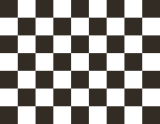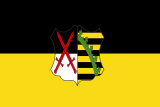Flag of Saxony
Both the civil and state flag of the German state of Saxony feature a bicolour of white over green, similar to the Austrian province of Styria. The state flag is similar to the civil flag, except it is defaced in the centre with the coat of arms of Saxony. The colours of both flags were officially decided as state colours in 1815.[1] The aristocracy used mostly and in first time the quadrangular and later the rectangular form.
Overview
The civil bicolour flag of white over green was used before World War II, and formally abolished in 1935, under the reforms of the Third Reich. It was readopted 1945 when Saxony became a state again, and abolished 1952 under governing reforms of the German Democratic Republic. When Germany was reunited, Saxony became a state again, and so the flag was finally officially readopted in 1991, having been a much used symbol during the demonstrations in the German Democratic Republic in 1989/90.[2]
Gallery
| Previous versions |
|---|
| War flag with cannons, bombs, lances and one Fire Salamander, who can live in, eat and his drunken blood protects from fire (1697-1706; 1709-1763) |
|
See also
References
- ↑ State Chancellery (1991), Gesetz über das Wappen des Freistaates Sachsen vom 18. November 1991 (Law on the arms of the Free State Saxony of 18 November 1991)
- ↑ Siobhán Ryan (2002-03-19), Verwaltungsvorschrift des Sächsischen Staatskanzlei über die Beflaggung der Dienstgebäude im Freistaat Sachsen (Administrative Regulation of the Saxon Prime Minister's Office on the Display of Flags in Official Buildings in the Free State of Saxony) (in German)

.svg.png)


.svg.png)










.svg.png)

.svg.png)
.svg.png)

